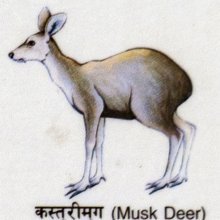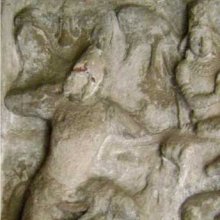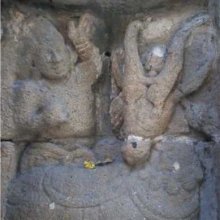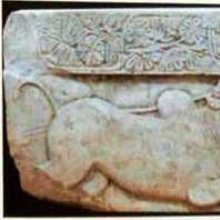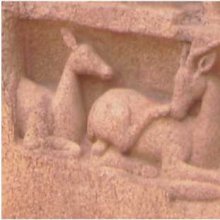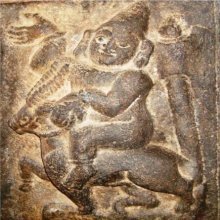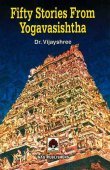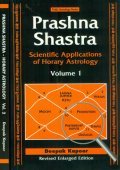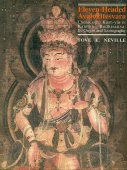Deer: 2 definitions
Introduction:
Deer means something in Buddhism, Pali, Hinduism, Sanskrit. If you want to know the exact meaning, history, etymology or English translation of this term then check out the descriptions on this page. Add your comment or reference to a book if you want to contribute to this summary article.
Images (photo gallery)
(+60 more images available)
In Hinduism
Natyashastra (theatrics and dramaturgy)
Source: Shodhganga: Elements of Art and Architecture in the Trtiyakhanda of the Visnudharmottarapurana (natya)1) The Deer is denoted by the Sanskrit term Mṛga, whereas Mṛgaśīrṣa-hasta refers to one of the twenty-two Single-hand Gestures (in Indian Dramas) (known as asaṃyuktahastas), according to the Viṣṇudharmottarapurāṇa, an ancient Sanskrit text which (being encyclopedic in nature) deals with a variety of cultural topics such as arts, architecture, music, grammar and astronomy.—The word mṛgaśīrṣa is the union of two words viz., mṛga and śīrṣa. The word mṛga means deer and śīrṣa means head. So, it can be said that the hand posture which is called mṛgaśīrṣa identifies a posture that looks like the head of a deer. According to the Viṣṇudharmottarapurāṇa, in mṛgaśīrṣahasta, all the fingers are bent downwards and only the small finger and the thumb go upward. At this position, the hand looks like a head of a deer with two horns. Abhinavagupta also keeps his view point in the same way and accepts mṛgaśīrṣa-hasta as a hand gesture which identifies the head of a deer with two horns.
2) Deers are also associated with Makarahasta: one of the thirteen Combined-hand Gestures (known as saṃyuktahastas).—According to the Śabdakalpadruma, makara means sea-animals like Kumbhīra, Kūrma, Kāca, Godhā, Śaṅkava, Śvaṇitaka, Śiśumāra etc. According to the Viṣṇudharmottarapurāṇa, in Makara posture both of the hands in patāka posture are placed one over the other and both should be facing downward. This posture is used in the acting of lion, tiger and deer.
3) The Gait of the Deer is denoted by the Sanskrit term Mṛgagati, and represents one of the various Gatis (“way of walking”) (in Indian Dramas), according to the Abhinayadarpaṇa.—Accordingly, gaits (gatis) are explained along with some particular hand gestures. It shows that footsteps are to be followed by some hand postures. The gait of mṛga itself identifies the footsteps of mṛga i.e., deer. To adopt this gait the actor or the dancer should run forward or sideways with tripatāka hands.

Natyashastra (नाट्यशास्त्र, nāṭyaśāstra) refers to both the ancient Indian tradition (shastra) of performing arts, (natya—theatrics, drama, dance, music), as well as the name of a Sanskrit work dealing with these subjects. It also teaches the rules for composing Dramatic plays (nataka), construction and performance of Theater, and Poetic works (kavya).
In Buddhism
Tibetan Buddhism (Vajrayana or tantric Buddhism)
Source: academia.edu: The Structure and Meanings of the Heruka MaṇḍalaThe Deer is associated with the Yoginī (female deity) named Mṛgī, being situated in the Medinīcakra, according to the 10th century Ḍākārṇava-tantra: one of the last Tibetan Tantric scriptures belonging to the Buddhist Saṃvara tradition consisting of 51 chapters.—Accordingly, the medinīcakra refers to one of the three divisions of the dharma-puṭa (‘dharma layer’), situated in the Herukamaṇḍala. The 36 pairs of Ḍākinīs [viz., Mṛgī] and Vīras are yellow in color; the shapes of their faces are in accordance with their names [e.g., Deer]; they have four arms; they hold a skull bowl, a skull staff, a small drum, and a knife.

Tibetan Buddhism includes schools such as Nyingma, Kadampa, Kagyu and Gelug. Their primary canon of literature is divided in two broad categories: The Kangyur, which consists of Buddha’s words, and the Tengyur, which includes commentaries from various sources. Esotericism and tantra techniques (vajrayāna) are collected indepently.
See also (Relevant definitions)
Starts with: Deer antler herb, Deer fern, Deer head, Deer Park, Deer pea, Deer tobacco, Deer-brush, Deer-foot, Deerbush, Deerghachhada, Deerghamala, Deerghashara, Deerghavraksha, Deergrass, Deeringia amaranthoides, Deers tongue.
Ends with: Kantir, Kitir, Spotted black deer.
Full-text (+1103): Mriga, Harina, Kuranga, Ranku, Ruru, Ajinayoni, Rajiva, Prishata, Pushkalaka, Saranga, Rohisha, Rohita, Mrigajina, Nyanku, Camuru, Maruka, Mriganabhi, Kasturi, Miga, Samura.
Relevant text
Search found 255 books and stories containing Deer; (plurals include: Deers). You can also click to the full overview containing English textual excerpts. Below are direct links for the most relevant articles:
The Markandeya Purana (Study) (by Chandamita Bhattacharya)
Marriage (a): Monogamy < [Chapter 2]
Women as Daughter < [Chapter 2]
Family Structure (Introduction) < [Chapter 2]
Tiruvaymoli (Thiruvaimozhi): English translation (by S. Satyamurthi Ayyangar)
Pasuram 10.9.11 < [Section 9 - Ninth Tiruvaymoli (Cul vicumpu ani mukil)]
Pasuram 2.10.6 < [Section 10 - Tenth Tiruvaymoli (Kilar oli ilamai)]
Pasuram 4.1.10 < [Section 1 - First Tiruvaymoli (Oru nayakamay)]
Folk Tales of Gujarat (and Jhaverchand Meghani) (by Vandana P. Soni)
Chapter 39 - Parkaya Pravesh < [Part 5 - Rang Chee Barot]
Pallava period (Social and Cultural History) (by S. Krishnamurthy)
Depcition of Hunting < [Chapter 4 - Material Culture of the People]
Wind instruments (Sushira) < [Chapter 4 - Material Culture of the People]
Depiction of Fauna < [Chapter 4 - Material Culture of the People]
Parables of Rama (by Swami Rama Tirtha)
Story 248 - The lion and other animals < [Chapter L - Ignorance]
Story 249 - The imagery of the hunter and his game < [Chapter L - Ignorance]
Story 202 - Lord Buddha and the hunter-King < [Chapter XXXVI - Universal Unity]
The Skanda Purana (by G. V. Tagare)
Chapter 85 - The Greatness of Somanātha Tīrtha < [Section 3 - Revā-khaṇḍa]
Chapter 6 - Seven Previous Births of the Deer-faced Lady and King Bhoja < [Section 2 - Vastrāpatha-kṣetra-māhātmya]
Chapter 23 - Greatness of Mṛga Tīrtha < [Section 1 - Tīrtha-māhātmya]
Related products
